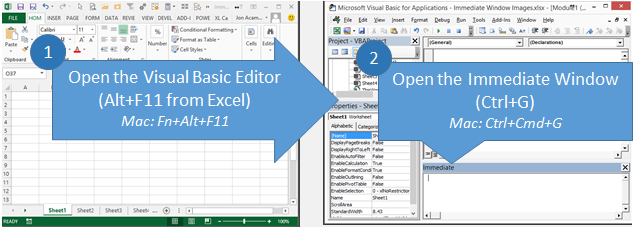

If you want to call a Function that has a return value you can use the GetMemoryAddress API function. It is possible to use Application.Run to return a value from a function.Įxactly the same thing can be achieved by using a subroutine and a ByRef argument. Calling Procedure assigned to a Variable Calling Function assigned to a Variable (with Arguments) The referenced file does not have to be open and is treated like an object library.Ģ) Use the Application.Run method and specify the filename and folder path of the other file.

To create a reference (Tools > References).Īfter a reference has been established you can call procedures in other files. Calling Procedure in a different fileġ) Create a reference to the other file. If the datatype of any of your paramaters (or of the returned datatype) is not declared then these items are assumed to have the Variant datatype.Īll the arguments are converted to values which means you cannot pass any objectsĪny objects passed as arguments to a macro will be converted to a value (by applying the Value property to the object). You must pass all the parameters as separate arguments and not as one single string (for example Application.Run("Macro(Arg1,Arg2,Arg3)") You cannot use named arguments with this method.
Excel for mac vba to call a subroutine code#
Is there a "best" way to make these kind of dynamic libraries? Are there Xcode templates anywhere? Example code anywhere? Thanks for any help.This can be used to run a macro written in Visual Basic or the Microsoft Excel macro language, or to run a function in a DLL or XLL. However, I would have to change a LOT of existing VBA code to make that work. Interestingly, I found that adding the 2nd declaration, which tells fortran it is not getting a string length, works as long as the VBA call does not pass the string length. I thought this should make the VBA work as written. The attributes declaration makes the subroutine pass by value (like C), name capitalization (like C) and gets rid of the trailing underscore fortran adds to the library subroutine name. This location is automatically searched by Excel. !DEC$ ATTRIBUTES C, DECORATE, ALIAS:'mySub' ::mySubĬompile the fortran code: ifort -dynamiclib -m32 mySub.for and rename myLib.dylib (how do I make it name it in the commandline?) Place myLib.dylib in ~/lib folder (create it in your home directory). Private Declare Sub mySub Lib "myLib.dylib" (ByVal myString As String, StringLength As Long) 'strings usually are passed a hidden 2nd string lengthĬall mySub(str, Len(str)) ' also seen as mySub(str, 8&) - which I also have no success with I can get functions to work passing doubles and singles.

Even code that works in MS Visual Studio and Intel Fortran does not work with strings on the Mac side as it appears it should with minor changes.
Excel for mac vba to call a subroutine windows#
I have a lot of existing Excel VBA code calling DLL's on Windows and I want to port these to Mac Excel. I have searched the forums as well as the net at large and learned a lot, but some sample code would help tremendously for me. Workbooks with these custom functions can be saved as XLAM files and made available to all workbooks.

Microsoft Office 2011 for Mac now allows VBA calls to external dynamic libraries.


 0 kommentar(er)
0 kommentar(er)
